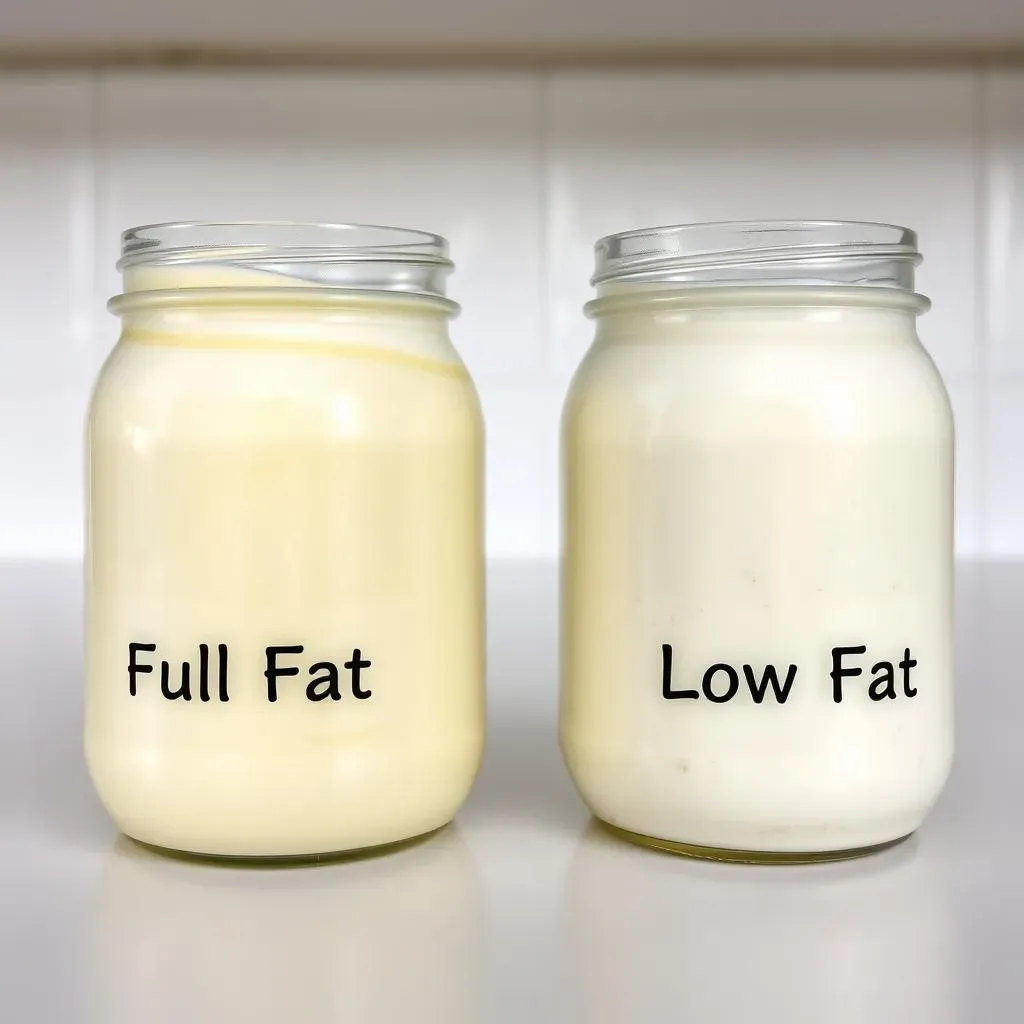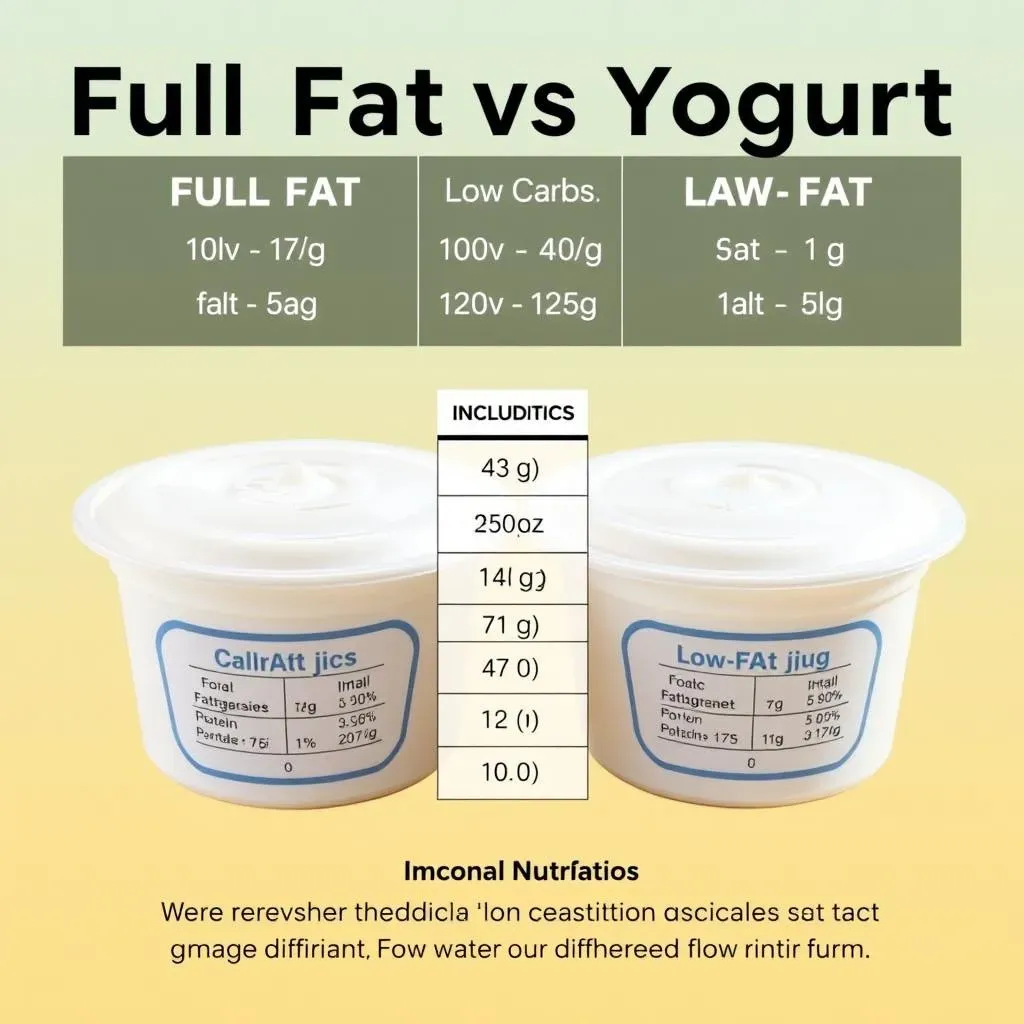Table of Contents
Yogurt, a staple in many diets, often sparks the "full fat yogurt vs low fat yogurt" debate. Navigating the dairy aisle can feel like deciphering a secret code, with countless options promising various health benefits. Which one truly reigns supreme? Is full fat the enemy, or does low fat miss out on crucial nutrients? This article cuts through the confusion, offering a clear comparison of full fat and low fat yogurt. We'll explore the nutritional profiles, debunk common myths, and help you determine which type best aligns with your individual dietary needs and preferences. Get ready to uncover the facts and confidently choose the yogurt that's right for you. We'll break down everything from calorie counts to the impact of fat on satiety, empowering you to make informed decisions about this popular food.
Decoding Yogurt: Full Fat vs. Low Fat FaceOff

Decoding Yogurt: Full Fat vs. Low Fat FaceOff
What Exactly Are We Talking About?
Let's get one thing straight: yogurt isn't just yogurt anymore. Walk down the aisle, and you're bombarded with choices. Greek, regular, flavored, drinkable – the list goes on. But at its core, the "full fat yogurt vs low fat yogurt" debate boils down to one simple ingredient: milk fat. Full-fat yogurt uses whole milk, retaining all its natural richness. Low-fat or nonfat yogurt, on the other hand, starts with skim milk, drastically reducing the fat content. It's that basic difference that sets the stage for everything else.
Think of it like this: full-fat yogurt is like a classic diner cheeseburger – all the ingredients, no compromises. Low-fat is like ordering that same burger with the cheese scraped off. You're saving some calories, sure, but you might be missing something in the process. But what is it you are missing? Let's see if the "missing" part is important or not!
The Production Process: How Fat Content Changes Things
The magic of yogurt happens through fermentation. Bacteria chow down on the milk's lactose, creating lactic acid, which thickens the milk and gives yogurt its signature tang. For full-fat yogurt, the process is pretty straightforward. Whole milk is cultured, resulting in a creamy, rich product. Low-fat yogurt is made with skim milk. This leads to a thinner consistency. Manufacturers often add thickeners like cornstarch or gelatin to mimic the texture of full-fat versions. This is where things get interesting. To compensate for lost flavor, some brands pump up the sugar content in low-fat options.
So, while you might be saving on fat, you could be loading up on other less desirable ingredients. This is where reading labels becomes crucial. Don't just grab the "low-fat" label and assume it's automatically healthier. Take a peek at the sugar content, the ingredient list, and see what else is lurking beneath the surface. Sometimes, the "healthier" choice isn't so clear-cut.
Nutritional Showdown: Comparing Full Fat and Low Fat Yogurt

Nutritional Showdown: Comparing Full Fat and Low Fat Yogurt
Calories and Macros: The Numbers Game
let's break down the nitty-gritty. When it comes to "full fat yogurt vs low fat yogurt," the most obvious difference is calorie count. Full-fat yogurt packs more calories due to its higher fat content. But before you freak out, remember calories aren't the enemy. They're fuel! The key is understanding what those calories bring to the table. Full-fat options boast more fat, obviously, which influences satiety. Low-fat yogurt cuts down on fat and therefore calories, making it seem like a dieter's dream. However, this often comes at a cost, as manufacturers frequently add sugar to compensate for flavor loss.
It's a balancing act. Are you prioritizing lower calorie intake above all else? Or are you looking for a more satisfying snack that might keep you fuller for longer, even if it has a few extra calories? Thinking about your overall dietary goals is key here. There are many different variations of fat content in yogurts. Make sure you check the labels before you buy!
Protein, Carbs, and the Hidden Sugars
Beyond calories, let's zoom in on protein and carbs. Both full-fat and low-fat Greek yogurts shine as protein powerhouses. Protein is your friend, aiding in muscle repair and keeping you feeling satisfied. The carb content is where things can get sneaky. Plain, unflavored yogurt, regardless of fat content, naturally contains some sugar (lactose). The real issue is added sugars. Many low-fat yogurts are loaded with sweeteners to enhance flavor, negating some of the benefits of reducing fat. Always scrutinize the nutrition label for added sugars. Aim for yogurts with minimal or no added sugars to truly reap the health rewards.
Nutrient | Full-Fat Greek Yogurt (1 cup) | Nonfat Greek Yogurt (1 cup) |
|---|---|---|
Calories | 220 | 130 |
Fat | 12g | 0g |
Protein | 20g | 22g |
Carbohydrates | 8g | 6g |
Sugar | 8g | 6g |
Vitamins, Minerals, and Probiotic Power
Don't forget the micronutrients! Both full-fat and low-fat yogurts are excellent sources of calcium, crucial for bone health. They also offer potassium, which plays a role in blood pressure regulation. And then there are the probiotics – the friendly bacteria that support gut health. Yogurt is a fermented food, meaning it naturally contains these beneficial microorganisms. However, not all yogurts are created equal. Look for yogurts with "live and active cultures" listed on the label to ensure you're getting a good dose of probiotics. The fat content doesn't necessarily impact the probiotic count, so this is one area where both full-fat and low-fat options can deliver.
So, while the "full fat yogurt vs low fat yogurt" debate often centers around calories and macros, remember to consider the broader nutritional picture. Vitamins, minerals, and probiotics all contribute to the overall health benefits of yogurt. It's important to find a brand that you love, and that also loves your gut!
Making the Right Choice: Tailoring Yogurt to Your Diet

Making the Right Choice: Tailoring Yogurt to Your Diet
Aligning Yogurt with Your Goals
so we've duked it out: "full fat yogurt vs low fat yogurt." Now, how do you actually pick the right one for *you*? It all boils down to your individual goals. Trying to shed a few pounds? Low-fat Greek yogurt can be a great, protein-packed option to keep you feeling full without a ton of calories. But, and this is a big but, make sure you're not sacrificing flavor for added sugar. Read those labels! On the other hand, if you're active and need sustained energy, or if you simply enjoy the taste and texture of full-fat yogurt, then go for it! The saturated fat in full-fat yogurt isn't the boogeyman it was once made out to be. Moderation is key, as always.
Think of yogurt as a tool, not a magic bullet. It's one piece of the puzzle in a healthy diet. Consider your overall calorie intake, your activity level, and your personal preferences. Don't be afraid to experiment and see what works best for your body. What fuels your friend might not fuel you. It's all about finding that sweet spot where taste, nutrition, and your goals intersect.
Beyond the Bowl: Creative Ways to Enjoy Yogurt
Yogurt doesn't have to be a boring breakfast. Let's get creative! Both full-fat and low-fat yogurts are incredibly versatile. Use them in smoothies for a protein boost, swap them for sour cream in dips, or even use them as a marinade for chicken. Get adventurous with toppings! Instead of sugary granola, try berries, nuts, and seeds. A drizzle of honey or a sprinkle of cinnamon can add sweetness without overloading on sugar. And don't forget savory options! Yogurt makes a fantastic base for tzatziki sauce or a cooling addition to spicy dishes.
The possibilities are endless. Whether you're a full-fat fanatic or a low-fat lover, there are countless ways to incorporate yogurt into your diet. The key is to focus on whole, unprocessed ingredients and to listen to your body. Pay attention to how different types of yogurt make you feel. Do you feel satisfied and energized? Or sluggish and bloated? Your body will tell you what it needs. And remember, the best diet is the one you can stick to long-term. Make it enjoyable, make it sustainable, and make it your own!
- Smoothie Booster: Add to smoothies for a creamy texture and protein kick.
- Dip Substitute: Replace sour cream in dips for a healthier twist.
- Marinade Magic: Use as a tenderizing marinade for meats.
- Topping Transformations: Opt for berries, nuts, and seeds over sugary granola.
- Savory Sensations: Create tzatziki sauce or use as a cooling element in spicy dishes.
The Final Scoop: Choosing the Right Yogurt for You
Ultimately, the "full fat yogurt vs low fat yogurt" debate has no definitive winner. The ideal choice hinges on your personal health goals, dietary needs, and taste preferences. Both options offer valuable nutrients and can be part of a balanced diet. If you're watching your calorie intake or saturated fat consumption, low fat yogurt might be a better fit. On the other hand, if you prioritize satiety and enjoy the richer flavor, full fat yogurt could be the way to go. Remember to consider added sugars and choose plain varieties whenever possible to maximize the health benefits. By understanding the nuances of each type, you can confidently select the yogurt that best supports your overall well-being.
